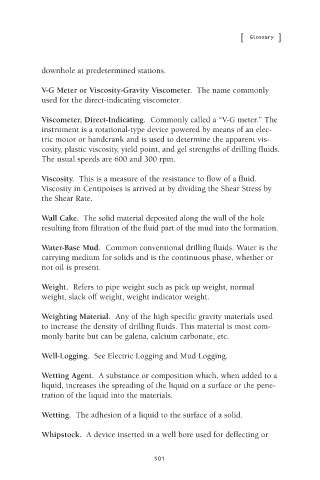Page 525 - Practical Well Planning and Drilling Manual
P. 525
Appendix NEW! revised 11/00/bc 1/30/01 3:30 PM Page 501
[ ]
Glossary
downhole at predetermined stations.
V-G Meter or Viscosity-Gravity Viscometer. The name commonly
used for the direct-indicating viscometer.
Viscometer, Direct-Indicating. Commonly called a “V-G meter.” The
instrument is a rotational-type device powered by means of an elec-
tric motor or handcrank and is used to determine the apparent vis-
cosity, plastic viscosity, yield point, and gel strengths of drilling fluids.
The usual speeds are 600 and 300 rpm.
Viscosity. This is a measure of the resistance to flow of a fluid.
Viscosity in Centipoises is arrived at by dividing the Shear Stress by
the Shear Rate.
Wall Cake. The solid material deposited along the wall of the hole
resulting from filtration of the fluid part of the mud into the formation.
Water-Base Mud. Common conventional drilling fluids. Water is the
carrying medium for solids and is the continuous phase, whether or
not oil is present.
Weight. Refers to pipe weight such as pick up weight, normal
weight, slack off weight, weight indicator weight.
Weighting Material. Any of the high specific gravity materials used
to increase the density of drilling fluids. This material is most com-
monly barite but can be galena, calcium carbonate, etc.
Well-Logging. See Electric Logging and Mud Logging.
Wetting Agent. A substance or composition which, when added to a
liquid, increases the spreading of the liquid on a surface or the pene-
tration of the liquid into the materials.
Wetting. The adhesion of a liquid to the surface of a solid.
Whipstock. A device inserted in a well bore used for deflecting or
501

